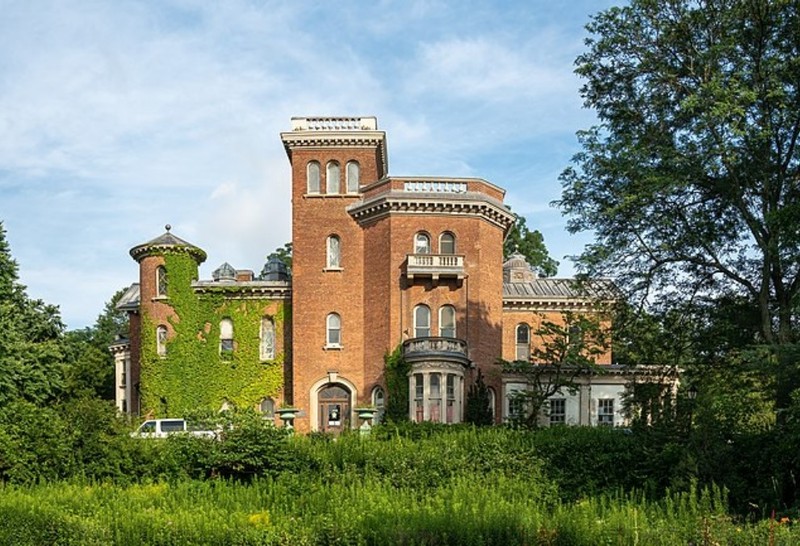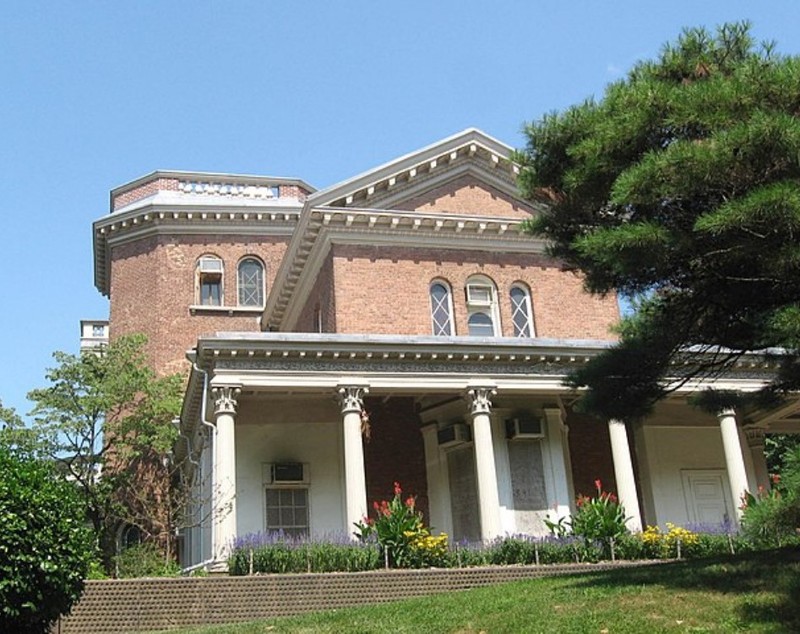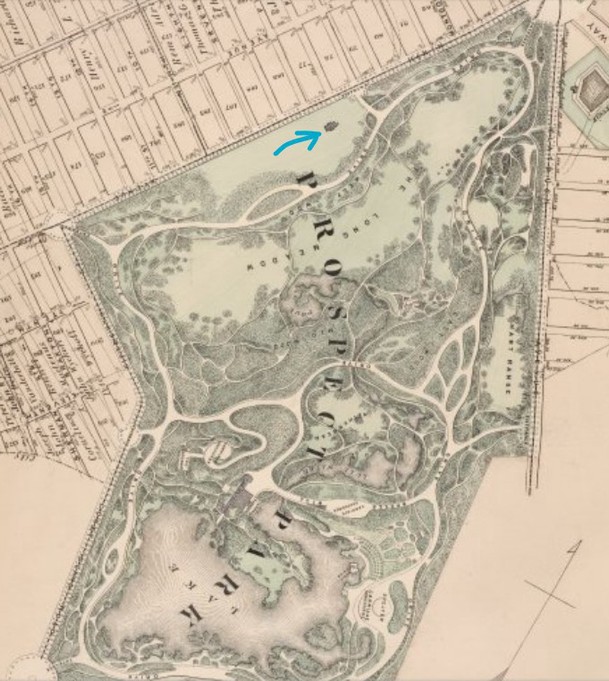Litchfield Villa (NYC Parks and Recreation)
Introduction
Text-to-speech Audio
The Italianate mansion in Prospect Park off of Prospect Park W. at 5th St. is Litchfield Villa, built in the mid-1850s. The house was designed by a leading architect, Alexander Jackson Davis, for Edwin Clark Litchfield, a railroad and real estate magnate. Litchfield objected to his home becoming part of Prospect Park, but the property was eventually bought from the family for $1.7 million in 1868. The family leased the property, covering 5 percent of the park's area, until 1882. In 1883, the mansion became the headquarters of the Brooklyn Park Commission. The building now houses the New York City Department of Parks and Recreation Brooklyn Borough headquarters and offices of the Prospect Park Alliance, an organization that helps maintain the park. The mansion was listed in the National Register in 1977.
Images
West (main) facade of Litchfield Villa in 2021 photo (Rhododendrites)

South side of Litchfield Villa in 2008 view (Jim.henderson)

Litchfield Villa/ Grace Hill (blue arrow) in Prospect Park on 1874 map (J.B. Beers & Co. p. 10)

Backstory and Context
Text-to-speech Audio
Litchfield Villa - sometimes called Litchfield's Castle - was constructed from 1854 to 1857 as a country estate. Lawyer and railroad mogul Edwin C. Litchfield and his wife, Grace Hill Hubbard, spent much of this time traveling in Europe, but kept in touch with architect Alexander Jackson Davis who went the extra mile for his wealthy client by overseeing construction of the mansion. The original estate designed by Jackson included a greenhouse, coach house, and chicken coop; none of these outbuildings have survived. The mansion was sited on 63 acres in the Park Slope area, on just one of the large parcels Litchfield owned. The Litchfield family moved into the mansion in the fall of 1857. While Davis had called the mansion Ridgewood, Litchfield referred to it as Grace Hill, in honor of his wife. The estate cost about $150,000 to develop.
Edwin and Grace Litchfield married in 1841. Their five children - Mary, Frances, Edward, Henry, and Grace - were born between 1842 and 1849. All of the Litchfields were New York natives. In 1860, the 45-year-old Edwin shared the mansion with Grace (age 36) and the four youngest children (not Mary), aged 10 to 16. Four servants from Switzerland or Ireland also lived in Grace Hill: Julie Hornell (25); Jane Hughes (20); Ellen Norton (30); and John Duffy (36). Edwin's real estate was valued at $300,000 and personal property was worth about $30,000. Three others with the surname Duffy - Bridget (46), James (8), and John (5) - lived in a house nearby, likely above the Litchfield coach house.
Litchfield Villa wasn't adopted as the estate's name until after the land was acquired from the Litchfields in 1869 to incorporate into Prospect Park. The family was given permission to live in the house as tenants and paid about $2,500 yearly in rent. Grace died in 1881 and Edwin left the unoccupied mansion behind in 1882, to become park offices. Edwin traveled in Europe until his death in 1885.
The front (west) entrance is within a square tower, in keeping with Italianate design; a round tower caps one front corner. The mansion was originally covered with stucco, likely scored by hand to resemble cut stone; the stucco was removed in the 1940s, revealing the underlying brick. Each side of the house is unique. The south porch columns are topped with capitals in a corn cob and wheat stalk motif (Corinthian style capitals usually feature an acanthus leaf motif). The interior was a complex combination of 30 rooms, some circular or octagonal. Upon entering the house, the visitor would be within an impressive, two-story circular hall below a sky-blue ceiling with a skylight and a second-floor gallery; the intricate mosaic tile floor was restored in 2007 with some of the funds donated by the Litchfield family. A number of arched doorways led from this hallway to other rooms, or to a grand, split stairway. Faux painting made the hall's walls look like granite and the doors like bronze.
Litchfield Villa now houses park offices and is the main information center of Prospect Park. Modern visitors usually only see the grand entry hall, but the exterior of the house can be viewed up close when the park is open. The 585-acre Prospect Park is the subject of another Clio entry and contains a Clio walking tour.
Sources
De Vries, Susan. How Litchfield Villa, the Picturesque Mansion of Prospect Park, Came to Be (Photos), Brownstoner. January 16th 2017 . Accessed February 14th 2022. https://www.brownstoner.com/architecture/litchfield-villa-prospect-park-alexander-jackson-davis-brooklyn-architecture-95-prospect-park-west/.
De Vries, Susan. The Mysterious Corncob Capitals of Prospect Park, Brownstoner. November 24th 2016. Accessed February 14th 2022.
https://www.brownstoner.com/architecture/brooklyn-architecture-corncob-column-95-prospect-park-west/
Druckman, Bella. The Top 10 Secrets of Litchfield Villa, Untapped New York. May 26th 2021. Accessed February 14th 2022. https://untappedcities.com/2021/05/26/secrets-of-litchfield-villa/?displayall=true.
Forgotten New York. Litchfield Villa, Prospect Park, Forgotten New York. July 7th 2015. Accessed February 14th 2022. https://forgotten-ny.com/2015/07/litchfield-villa-prospect-park/.
Prospect Park Alliance. Points of Interest - Litchfield Villa, Prospect Park Alliance: Visit the Park. January 1st 2022. Accessed February 14th 2022. https://www.prospectpark.org/visit-the-park/park-map/points-interest/points-interest-litchfield-villa/.
U.S. Census. Household of Edwin C. Litchfield in Brooklyn Ward 8 District 2, N.Y., dwelling 213, family 251. Washington, DC. U.S. Government, 1860.
https://en.wikipedia.org/wiki/Litchfield_Villa#/media/File:Litchfield_Villa_(14034p).jpg
https://en.wikipedia.org/wiki/Litchfield_Villa#/media/File:Litchfield_Villa_jeh.JPG
New York Public Library (NYPL): https://digitalcollections.nypl.org/items/64b4a3c1-7a84-19e1-e040-e00a180640e1
